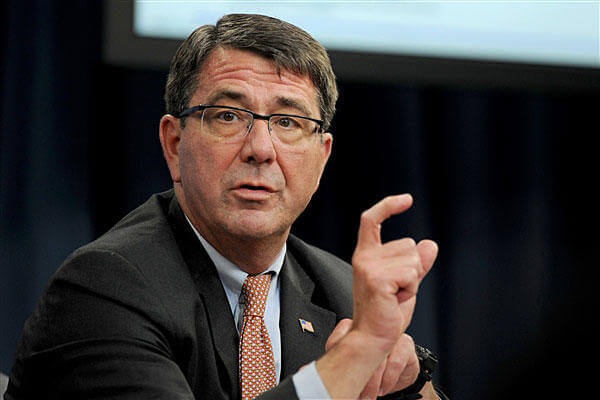Ashton Carter left the No. 2 job at the Pentagon as a known defender of the costly F-35 Joint Strike Fighter who also pushed a new age of armored vehicles onto the battlefield.
Now just 363 days after his retirement, Carter is poised to return as the next secretary of defense.
While not yet official, Washington was abuzz on Tuesday with reports that the Obama administration officials had tapped Carter as the top choice to succeed outgoing Defense Secretary Chuck Hagel.
Carter, who holds a doctorate in theoretical physics from Oxford University, was believed to be on President Obama's short list for the top Pentagon position in early 2013 when Leon Panetta resigned from the post, only to see the job go to Hagel.
One of Carter's main jobs as Hagel's deputy focused on reining in cost overruns on the Lockheed Martin F-35, the most expensive weapons system ever built with an estimated price tag of more than $390 billion.
Carter also served as the undersecretary of defense for acquisition, technology and logistics from 2009 to 2011. He oversaw the development of the Mine-Resistant Ambush Protected vehicle program, an effort that sent thousands of these heavily armored behemoths to Iraq and Afghanistan.
Carter helped create a special task force designed to evaluate which successful rapid acquisition practices could be leveraged for permanent use in the Pentagon's acquisition apparatus.
The White House wants to avoid the contentious hearings that Hagel faced. Carter, 60, has already been vetted by the Senate Armed Services Committee in 2012 hearings on his nomination as deputy secretary.
Republican Sen. Jim Inhofe of Oklahoma told the Associated Press that he was pleased with the administration's decision to select Carter.
"I support it very strongly," he said. "I'm very pleased he is going to be our secretary of defense. I can't imagine that he's going to have opposition to his confirmation."
Sen. John McCain, R-Arizona, who will take over the chairmanship of SASC next year, is already on record in praise of Carter for his oversight of acquisitions at the Pentagon.
McCain also claimed to be a friend of Hagel's from their days in Congress together, but that did not stop him from becoming one of Hagel's loudest critics during his confirmation hearing.
Carter could face tough questions on his oversight as deputy secretary of the F-35 Joint Strike Fighter program.
It would be wrong, however, to say that Carter was a fan of overly ambitious defense acquisitions programs. He chided the Army for depending too much on emerging technologies that did not yet exist during the development of the now-defunct Ground Combat Vehicle.
Carter saw the GCV as an example of how new weapons programs end up costing much more when schedules are stretched to accommodate additional development of future technologies.
Better Buying Power
While serving as the Pentagon's top weapons buyer, Carter lead the launch of a new Pentagon effort to improve the acquisition process called Better Buying Power.
Now poised to enter its fifth year, it's meant to lower prices by increasing competition and incentivize defense industry partners to maximize productivity. The program became famous for the "do more without more" phrase, meaning the Pentagon's acquisition apparatus would have to find ways to make dollars go further and become more efficient as budgets got tighter.
The program was not intended to necessarily reduce industry profit, but rather eliminate bureaucracy and improve productivity and efficiency. Since its inception in 2010, Better Buying Power has continued under current Pentagon acquisition chief Frank Kendall and even evolved in 2012 into a 2.0 version.
Better Buying Power, which is credited with helping the Pentagon save money on key programs such as the Virginia-class submarine and DDG 51 Arleigh Burke-class guided missile destroyer acquisition, is grounded in efforts to achieve greater affordability for programs and lower costs throughout the entire life-cycle of a program, to include reducing sustainment dollars.
-- Matthew Cox can be reached at Matthew.Cox@military.com.
-- Kris Osborn can be reached at Kris.Osborn@military.com.


























